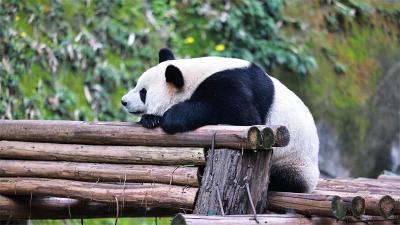Chongqing Dazu Rock Carvings
Located 163km northwest of Chongqing, Dazu Rock Carving or named Dazu Grottoes is the collective term for 141 cliff-carved statue sites dotted around Dazu District, and include more than 50,000 Buddhist, Taoist and Confucian rock carvings and 100,000 characters of inscriptions, which are mainly found on North Hill (Beishan Hill) and Baoding Hill. They date from Tang Dynasty (9th century) to Song Dynasty (13th century).
Regarded as a masterpiece of the later period of ancient Chinese cave art, and one of the most famous Buddhist grottoes in China, the Dazu Rock Carvings ranks alongside the Yungang Grottoes in Datong, Shanxi, the Longmen Grottoes in Luoyang, Henan, and the Mogao Caves in Dunhuang, Gansu.
In December 1999, the Dazu Rock Carvings were included in the UNESCO World Heritage List - the only world cultural heritage site in Chongqing. It is a must-visit when you travel in Chongqing.
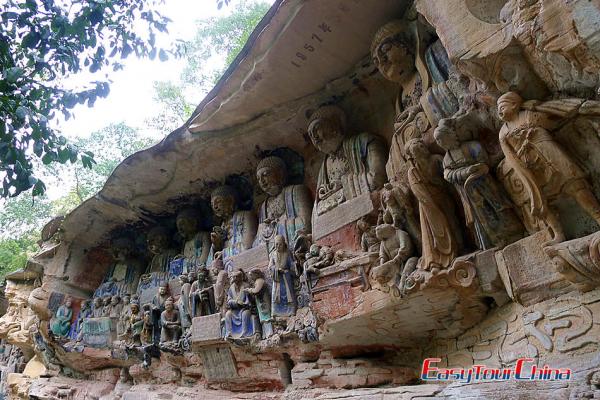
Dazu Rock Carvings Facts
History of Dazu Rock Carvings
Buddhist cave art originated in ancient India and was introduced to China in the 3rd century AD. Two major peaks in its development occurred in northern China around the 5th and 7th centuries (from the Wei and Jin dynasties to the peak of the Tang dynasty), but it began to decline by the mid-8th century (after the Tianbao era of the Tang dynasty).
Amid this period of discontinuity, cliff-side carvings emerged unexpectedly in Dazhu County within the Yangtze River basin. From the late 9th to the mid-13th century, the Dazhu Stone Carvings—represented by the “Five Mountains” cliff-side sculptures—were completed, marking another peak in China's cave art history and extending its legacy for over 400 additional years.
Thereafter, Chinese cave art stagnated, with no new large-scale caves carved elsewhere. The Dazu Carvings thus became the final monumental achievement of China's great dynasties.
During the Yonghui era of the Tang Dynasty (650–655), the Dazhu Rock Carvings commenced with the cliff-side sculptures at Jianshanzi. Over the subsequent two centuries, new carvings such as those at Shengshui Temple were added.
During the Five Dynasties and Ten Kingdoms period (907–965), carvings concentrated primarily on the Beishan Rock Carvings. Statues from this era are characterized by their delicate, petite forms, varied postures, graceful expressions, and increasingly ornate decorative patterns.
During the early Northern Song Dynasty, the Dazhu region primarily featured temple sculptures in the form of full-body round sculptures. In the middle and late Northern Song Dynasty, stone carving sculptures experienced a resurgence. Beginning with the carving of the Buddhist, Taoist, and Confucian “Three Teachings” sculpture area on Shizhuanshan Mountain by the large estate owner Yan Xun in the fifth year of Yuanfeng of the Southern Song Dynasty (1082), a total of 32 Buddhist, Taoist, and “Three Teachings” sculpture areas were successively carved. The Nanshan and Shimen Mountain carving zones, along with the Beishan Duobao Pagoda, were all completed during this period. The Beishan carving zone, whose carving began in the first year of the Jingfu era of the Tang Dynasty (892), took over 250 years to complete, finally finishing in the sixteenth year of the Shaoxing era of the Southern Song Dynasty (1146).
During the early Southern Song Dynasty, the carving of stone sculptures in Dazhu reached its zenith. The Northern Mountain's Sutra Repository Cave became a gathering place for exquisite divine figures. The Confucian, Buddhist, and Taoist sculptures at South Mountain, Stone Gate Mountain, and Miagao Mountain demonstrated the deep integration of the Three Teachings into Chinese folk culture.
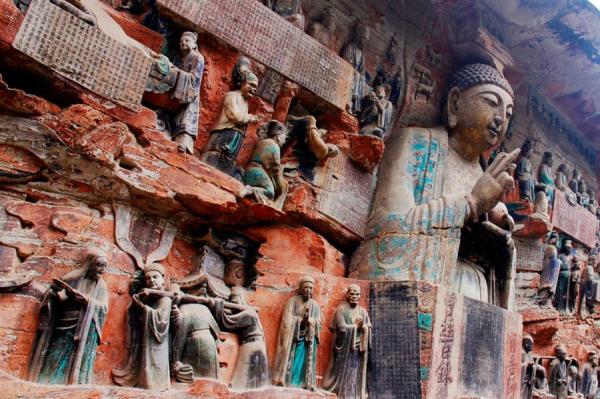
During the 70-plus years from the Chunyu to Chunyu reigns (1174–1252) of the Southern Song Dynasty, the renowned Sichuan monk Zhao Zhifeng endured over 70 years of asceticism, raising funds from all quarters. He presided over the carving of nearly 10,000 Buddhist statues at Baoding Mountain, establishing the only large-scale stone cave monastery in the history of Chinese Esoteric Buddhism and bringing the Dazhu Stone Carvings to their zenith.
>> Recommended Chongqing tours with Dazu Rock Carvings
Top Things to See & Do: Dazu Rock Carvings Highlights
North Hill (Beishan)
Just about a 30 minute hike from Dazu town, North Hill sculptures include over 10,000 figures of Buddhas and Bodhisattvas in various poses; they are famous for their elegance and exquisiteness. The development of Chinese grotto art is obvious as one compares figures from earlier and later periods.
The figures carved during the Tang Dynasty are decorous, full and round in appearance, and simple and honest in temperament. The sculptures carved during the period of the Five Dynasties are ingenious, subtle, and dainty, with natural and unrestrained looks.
The images from the time of the Song Dynasty are graceful in posture and well-proportioned in physical build; their garments are gorgeous beyond description. Human beings and deities are ingeniously and skillfully merged in the sculptures.
>> Recommended 7-day Chongqing & Chengdu Combo Tour
Baoding Hill (Baodingshan)
About 15km northeast of Dazu town, the sculptures at Baoding Hill comprise the best of Dazu Carving's art. The founding work is attributed to Zhao Zhifeng (1179-1245), a monk from the Esoteric Sect of Tantric Buddhism.
The masterpiece is a 31m-long, 5m-high reclining Buddha, depicted in the state of entering nirvana. Statues around the rest of the 125m horseshoe vary considerably: Buddhist sages and preachers, historical figures, realistic scenes and delicate sculptures a few centimeters in height.
The sculptures demonstrate a skillful combination of scientific principles and artistic models, reflecting the rich social context and very flavor of life of ancient Chinese people.
>> Related reading: 8 Giant Buddha Statues in China
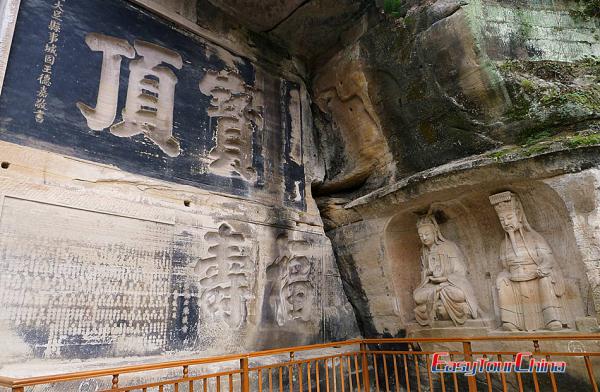
Shuchengyan
A masterpiece among the Dazu Carvings, the Shuchengyan Cliff Carvings are located in Dawu Village, Zhongao Town, Dazu District, Chongqing Municipality. These Taoist cliff carvings Carved between the 13th and 23rd years of the Shaoxing era of the Southern Song Dynasty (1143–1153), the cliff face spans 38 meters in length and 6.5 meters in height, featuring 11 caves. Over 70 statues and 13 inscriptions remain today. Primary subjects include Empress Shuming, the Eastern Peak Emperor, the Purple Micro Emperor, the Three Purities, the Jade Emperor, and other Taoist deities.
Miaogao Mountain
Located in Shuguang Village, Jijia Town, Dazu District, Chongqing, the Miaogao Mountain cliff carvings primarily feature Buddhist sculptures, with only one cave housing a tripartite carving integrating Confucian, Buddhist, and Taoist elements. The cliff face measures 35 meters in length and 13 meters in height, containing eight cave niches. These carvings were created during the Southern Song Dynasty's Shaoxing era (1131–1162).
Duobao Pagoda
Another masterpiece of the Dazu Rock Carvings, the Duobao Pagoda is situated in Longgang Subdistrict, Dazu District, Chongqing. Constructed between the 18th and 25th years of the Southern Song Dynasty's Shaoxing era (1148–1155), Standing 33 meters tall, this octagonal pagoda features a multi-eaved, multi-story structure built with brick and stone. Over 140 niches with high-relief stone carvings adorn its interior and exterior levels, alongside more than 70 inscriptions and commemorative steles.
>> Recommended 5 days Chongqing Jiuzhaigou Tour
Dazu Rock Carvings Museum
Opening hours: 9:00 AM - 5:00 PM
This specialized museum showcases the development of global cave art and the fundamental characteristics of the Dazu Rock Carvings. With a total floor area of 18,000 square meters and exhibition space of 5,000 square meters, its architectural design incorporates elements from the carvings' imagery, embodying a unique blend of Tang and Song dynasty styles.
Digital Cinemas
The digital films of Dazu Rock Carvings are divided into 4K cinemas and spherical cinemas (8K).
The 4K wide-screen film "Dazu World": The cinema area is approximately 790 square meters, and the film lasts for 23 minutes. It mainly tells the magnificent history of the Dazu Rock Carvings over a thousand years ago and the spirit of ancient Chinese craftsmen who carved mountains and rocks and worked diligently, showcasing the historical status and cultural value of the Dazu Rock Carvings in the history of Chinese cave carvings.
The 8K spherical film "Dazu Rock Carvings": The cinema area is approximately 1,300 square meters, and the film lasts for 18 minutes. The 8K high-resolution images, combined with its unique immersive experience, allow viewers to view dozens of exquisite caves of Dazu Rock Carvings from all angles and perspectives.
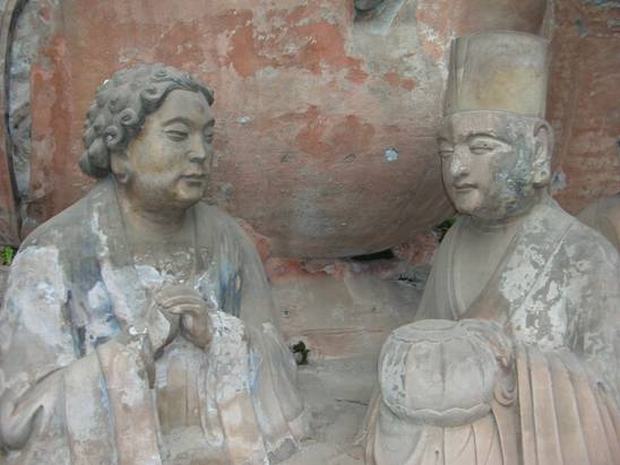
Ticket Prices for All Attractions
| Ticket Type | Full Price (CNY/person) | Half Price (CNY/person) | Free Ticket |
| Baoding Mountain Scenic Area (incl. Shengshou Temple) | Peak Season: 115O; ff Season: 100 | Peak Season: 55O; ff Season: 50 | |
| North Mountain Scenic Area | Peak Season: 70O; ff Season: 50 | Peak Season: 35O; ff Season: 25 | |
| South Mountain Scenic Area | Peak/Off Season: 30 | Peak/Off Season: 15 | |
| Shimen Mountain Scenic Area | Peak/Off Season: 30 | Peak/Off Season: 15 | |
| Shizhuan Mountain Scenic Area | Peak/Off Season: 30 | Peak/Off Season: 15 | |
| Digital Dome Cinema (8K Dome, 4K Giant Screen) | 80 | Children under 6 years old (without a seat): free | |
| Baoding Mountain Scenic Area Shuttle Bus (Tourist Bus & Sightseeing Car) | Round trip: 22; One way: 12 | Children under 6 years old free |
Please note:
1. Peak season: March 1 – November 30; Off season: December 1 – February 28/29.
2. Half-price tickets/free tickets exclude Digital Dome Cinema and Baoding Mountain Scenic Area shuttle bus.
Best time to visit
The area where the Dazu Rock Carvings are located, Chongqing City, has a subtropical monsoon climate. The climate is mild and humid, with an average annual rainfall of 900 to 1100 millimeters. All four seasons are suitable for visiting the Dazu Rock Carvings.
>> Recommended 15-day Sichuan+Yangtze Tour Package
How to Get to Dazu Rock Carvings
By Plane: Arrive at Chongqing Jiangbei Airport - Chongqing Airport T2/T3 Long-distance Bus Station - Dazu Bus Station - 205 Bus/Taxi - Dazu Stone Carvings Tourist Center
By Train: Arrive at Dazu South Station - 204 Bus (get off at Telecommunication Bureau Station)/206 Bus (get off at Hongsheng Square Station) - 205 Bus (get on at Telecommunication Bureau Station)/2015 Stone Carvings Special Line (get on at Hongsheng Cultural Square Station)/Taxi - Dazu Stone Carvings Tourist Center
By Long-distance Bus: Arrive at Dazu Bus Station - 205 Bus/Taxi - Dazu Stone Carvings Tourist Center (Bus tickets can be viewed and purchased at Yukeheng Chongqing Road Passenger Transport Ticketing Network)
More Attractions in Chongqing
